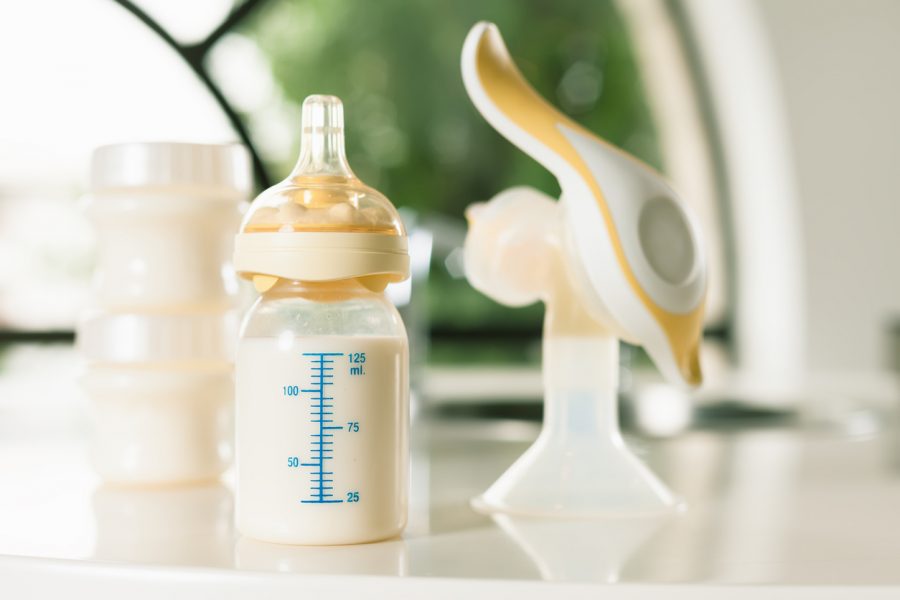
Maybe you’re getting ready to return to work after maternity leave or maybe you just want to have a milk stash on hand for a babysitter. No matter what your situation, the chances are good that you’re going to have to break out that all-too elusive breastmilk pump at one point or another.
And whether you’re new to the pumping game, or you’ve been at it for a while, we would wager to bet you’ve got some questions. Should you pump both sides every time? (The answer is yes, according to Medela.com). Is it OK to miss a pump session? (Also a yes, provided your milk supply is well established).
We caught up with lactation consultant and pumping expert, Colette Acker to ask our most pressing pumping questions. An International Board Certified Lactation Consultant of 20 years, Colette has worked in both the hospital and outpatient world of breastfeeding and is currently the director of the Breastfeeding Resource Center, a community based, non-profit organization. Colette has dedicated her career to supporting breastfeeding families, which makes her the perfect candidate to answer all of our questions about pumping.
Here is what our favorite lactation consultant had to say about pumping:
1. It’s date night and I’m exclusively breastfeeding. I’ve got a few bottles ready, but don’t know what to do about pumping. Do I HAVE to pump for every bottle he drinks? And how close does it have to be to when he is drinking? Can I make up for it by pumping when I get home a few hours later or even pumping earlier in the day?
Before the baby was born, it seemed simple to think about pumping your milk for a night out, but when that day comes, many families struggle with the plan. Having a few bottles ready is a great start. You can feel confident that your baby will have enough to drink while you’re gone.
Maintaining your milk supply while you’re away is the second part of the process. The number of times you’ll need to pump will depend on how long you’re going out. A good rule of thumb will be to express your milk every three hours. If you’re only missing one feeding, you can nurse the baby once home and you may want to pump directly after to give your body that extra boost. If you’ll be missing two feedings, I would suggest pumping at least once while you’re out.
2. Speaking of date night: What if I want to have a drink or two? What considerations do I need to make? Is the pump and dump concept still relevant or am I ok to wait a little and breastfeed my baby?
Having a drink will not impact your baby negatively. A good rule of thumb is that you don’t want to nurse your baby if you’re feeling tipsy. But there is no need to pump and dump. Once you’re feeling “untipsy,” you can safely nurse your baby.
You May Also Like: 7 Breastfeeding Myths You Have to Stop Believing >
3. What’s the best way to prepare for going back to work? When should I start pumping and how often should I do it if I need to build up a stash? Can I do it a few times a week or do I need to do it consistently – at the same time every day?
I encourage mothers to begin pumping at about three to four weeks postpartum. Pumping once a day about a half hour after the morning feeding gives most mothers the best result. Moms tend to have more milk in the morning. Store each pumping session in the refrigerator. Once you’ve collected three to four ounces, you can begin offering the baby a bottle.
Allow a family member or friend to offer the baby the bottle. Once the baby takes it happily and is sated after the feeding, mom should pump again since the baby will be skipping a feeding. That milk can be stored in the freezer for later use. Mom can continue pumping in the morning for the baby’s practice bottle. She can pump when the baby takes the practice bottle and continue to store that milk in the freezer. This allows mom to collect a freezer stash and allow baby to practice bottle-feeding.
4. Do you suggest doing frequent, shorter pumping sessions or fewer, longer ones?
In order to maintain your milk production, frequency is more important than the length of the pumping session. For example, if a mother has returned to work, two or three pumping sessions for about 15 minutes will maintain her milk production better than doing one 45 minutes pumping session.
You May Also Like: Everything You Need to Know About Breastfeeding >
5. Is pumping a good indication of how much milk your baby is getting? If a pumping sessions yields little to no milk, should you panic?
All mothers respond to pumps differently. If your breastfed baby is thriving and you’re unable to collect milk when you pump, it could be the pump, not you. The type of pump, the time of day you express, and your milk supply all play a part in your success. If you’re struggling, I would suggest making an appointment with an IBCLC.
6. What is the difference between cleaning your pump parts and sterilizing them? How often should you do each?
Washing and sterilizing your pump parts is important to do before the first use. After the initial sterilization, it is not necessary to do it again.
Washing with hot, soapy water is sufficient. Some mothers choose to sterilize once a week just to be sure the pump parts remain clean. If you’re pumping for a premature baby or a baby with a weakened immune system, sterilizing more often is recommended



